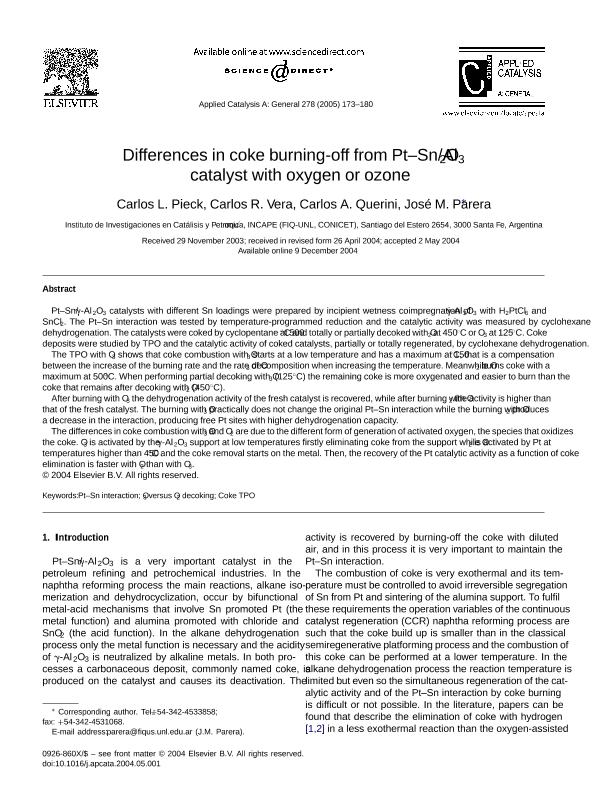Mostrar el registro sencillo del ítem
dc.contributor.author
Pieck, Carlos Luis

dc.contributor.author
Vera, Carlos Roman

dc.contributor.author
Querini, Carlos Alberto

dc.contributor.author
Parera, Jose

dc.date.available
2019-04-02T19:52:15Z
dc.date.issued
2005-01
dc.identifier.citation
Pieck, Carlos Luis; Vera, Carlos Roman; Querini, Carlos Alberto; Parera, Jose; Differences in coke burning-off from Pt-Sn/Al2O3 catalyst with oxygen or ozone; Elsevier Science; Applied Catalysis A: General; 278; 2; 1-2005; 173-180
dc.identifier.issn
0926-860X
dc.identifier.uri
http://hdl.handle.net/11336/73024
dc.description.abstract
Pt-Sn/γ-Al2O3 catalysts with different Sn loadings were prepared by incipient wetness coimpregnation of γ-Al2O3 with H2PtCl 6 and SnCl2. The Pt-Sn interaction was tested by temperature- programmed reduction and the catalytic activity was measured by cyclohexane dehydrogenation. The catalysts were coked by cyclopentane at 500 °C and totally or partially decoked with O2 at 450 °C or O3 at 125 °C. Coke deposits were studied by TPO and the catalytic activity of coked catalysts, partially or totally regenerated, by cyclohexane dehydrogenation. The TPO with O3 shows that coke combustion with O3 starts at a low temperature and has a maximum at 150 °C, that is a compensation between the increase of the burning rate and the rate of O3 decomposition when increasing the temperature. Meanwhile O2 burns coke with a maximum at 500 °C. When performing partial decoking with O3 (125 °C) the remaining coke is more oxygenated and easier to burn than the coke that remains after decoking with O2 (450 °C). After burning with O3 the dehydrogenation activity of the fresh catalyst is recovered, while after burning with O2 the activity is higher than that of the fresh catalyst. The burning with O3 practically does not change the original Pt-Sn interaction while the burning with O2 produces a decrease in the interaction, producing free Pt sites with higher dehydrogenation capacity. The differences in coke combustion with O3 and O2 are due to the different form of generation of activated oxygen, the species that oxidizes the coke. O3 is activated by the γ-Al2O3 support at low temperatures firstly eliminating coke from the support while O2 is activated by Pt at temperatures higher than 450 °C and the coke removal starts on the metal. Then, the recovery of the Pt catalytic activity as a function of coke elimination is faster with O2 than with O3.
dc.format
application/pdf
dc.language.iso
eng
dc.publisher
Elsevier Science

dc.rights
info:eu-repo/semantics/openAccess
dc.rights.uri
https://creativecommons.org/licenses/by-nc-sa/2.5/ar/
dc.subject
Coke Tpo
dc.subject
O3 Versus O2 Decoking
dc.subject
Pt-Sn Interaction
dc.subject.classification
Otras Ciencias Químicas

dc.subject.classification
Ciencias Químicas

dc.subject.classification
CIENCIAS NATURALES Y EXACTAS

dc.title
Differences in coke burning-off from Pt-Sn/Al2O3 catalyst with oxygen or ozone
dc.type
info:eu-repo/semantics/article
dc.type
info:ar-repo/semantics/artículo
dc.type
info:eu-repo/semantics/publishedVersion
dc.date.updated
2019-04-01T16:12:17Z
dc.journal.volume
278
dc.journal.number
2
dc.journal.pagination
173-180
dc.journal.pais
Países Bajos

dc.journal.ciudad
Amsterdam
dc.description.fil
Fil: Pieck, Carlos Luis. Consejo Nacional de Investigaciones Científicas y Técnicas. Centro Científico Tecnológico Conicet - Santa Fe. Instituto de Investigaciones en Catálisis y Petroquímica "Ing. José Miguel Parera". Universidad Nacional del Litoral. Instituto de Investigaciones en Catálisis y Petroquímica "Ing. José Miguel Parera"; Argentina
dc.description.fil
Fil: Vera, Carlos Roman. Consejo Nacional de Investigaciones Científicas y Técnicas. Centro Científico Tecnológico Conicet - Santa Fe. Instituto de Investigaciones en Catálisis y Petroquímica "Ing. José Miguel Parera". Universidad Nacional del Litoral. Instituto de Investigaciones en Catálisis y Petroquímica "Ing. José Miguel Parera"; Argentina
dc.description.fil
Fil: Querini, Carlos Alberto. Consejo Nacional de Investigaciones Científicas y Técnicas. Centro Científico Tecnológico Conicet - Santa Fe. Instituto de Investigaciones en Catálisis y Petroquímica "Ing. José Miguel Parera". Universidad Nacional del Litoral. Instituto de Investigaciones en Catálisis y Petroquímica "Ing. José Miguel Parera"; Argentina
dc.description.fil
Fil: Parera, Jose. Consejo Nacional de Investigaciones Científicas y Técnicas. Centro Científico Tecnológico Conicet - Santa Fe. Instituto de Investigaciones en Catálisis y Petroquímica "Ing. José Miguel Parera". Universidad Nacional del Litoral. Instituto de Investigaciones en Catálisis y Petroquímica "Ing. José Miguel Parera"; Argentina
dc.journal.title
Applied Catalysis A: General

dc.relation.alternativeid
info:eu-repo/semantics/altIdentifier/doi/http://dx.doi.org/10.1016/j.apcata.2004.05.001
Archivos asociados
